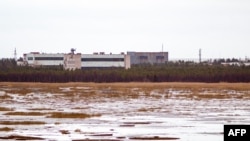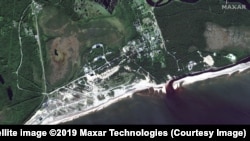Researchers at a Norwegian institute believe that there may have been two explosions, not one, at the Russian naval test site on the White Sea earlier this month, an incident that killed at least five people and raised new questions about Russia's weapons research.
The conclusions were published on August 14 by the Norsar Research Institute, based on seismographic and acoustic readings taken the day of the deadly incident, but had gone largely unnoticed.
Anne Lycke, the institute's chief executive, told RFE/RL in an interview on August 23 that the institute's monitoring stations first detected seismographic readings on August 8 at around 9 a.m. local time in Arkhangelsk, a major city on the White Sea.
The readings, she said, pointed to an explosion that occurred somewhere close to the Earth's surface, either on ground or on water.
Around two hours later, at 11 a.m., a different sensor designed to pick up infrasound, or low-frequency sound, registered another, different acoustic event, Lycke said.
Researchers concluded that that was likely an explosion that occurred in the air, some height above the ground, she said.
"Yes, it appears that two explosions took place, based on our findings," Lycke said.
The institute's findings, which were first reported by the newspaper Afternposten on August 22, add to a growing body of publicly available evidence about the August 8 incident that took place at the Nyonoksa naval test site, a range on the White Sea that has been used for decades by Soviet and Russian military planners.
Contradictory Information
Russian authorities have released scattered and sometimes contradictory information about the mishap, which has added to anger among Russians about what exactly happened and whether there was any danger.
The Defense Ministry revealed the incident the same day it happened, saying two people had been killed, but gave no details. Two days later, the state-run nuclear agency Rosatom revealed that five of its scientists had been killed while they were conducting "technical-engineering oversight" of a test of "radioactive isotope fuel for a liquid-fueled rocket engine."
The following day, on August 11, managers at the state research institute where the five were employed revealed in a video interview that the researchers had been investigating, among other things, "the creation of small-scale sources of energy using radioactive fissile materials."

In the communities near Nyonoksa, including the cities of Severodvinsk and Arkhangelsk, many Russians have been angered by the lack of clear information from authorities. In the hours after the incident, many of Severodvinsk's pharmacies were sold out of iodine drops. Iodine is often taken in the aftermath of a nuclear incident as a way to protect the thyroid gland from radiation.
Residents of the region also took to social media to discuss radiation levels and share videos of Geiger counters registered ambient radiation levels. Local sensors initially reported a brief spike in radiation in Severodvinsk, but the information quickly disappeared from official websites.
'Important Work'
Earlier this week, at a news conference alongside Finnish Prime Minister Antti Rinne in Helsinki, Russian President Vladimir Putin was asked about the incident.
"Unfortunately, the tragedy in the White Sea took the lives of our experts," he said. "This is work carried out in the military sphere, work on prospective weapon systems. We are not concealing this. The people who were injured or died were performing very important work for Russia's security."
Adding to anger in the region are reports that doctors and medical staff who treated the initial victims of the explosion, which included three survivors, had no information about what the incident was exactly, and that there was a risk of radiation exposure. Doctors have complained on social media, and in interviews, that they were given no protective equipment as they treated victims.
While nearby residents have worried about whether it was safe to eat fish or berries and mushrooms, Western analysts have scrambled to figure out what exactly was being tested at Nyonoksa.
Several analysts have suggested that it may have been a nuclear-powered cruise missile dubbed the Burevestnik in Russian. That's a weapon which President Putin himself boasted was under development last year.
And U.S. President Donald Trump added to the speculation by posting a tweet that stated outright that it was the Burevestnik, known to NATO analysts under the name Skyfall.
Other analysts said it might not be a nuclear-propelled, super-fast cruise missile, but a "radioisotope thermoelectric generator" used to generate power for a missile and its components.
'Doomsday Machine'
Still others have speculated it could be a new underwater nuclear drone -- dubbed the "doomsday machine" -- that is reportedly under development, or a hypersonic anti-ship missile known as the Tsirkon.
Lycke told RFE/RL that the institute's sensors detected the apparent airborne explosion, but they don't have enough data to conclude that it was caused by an exploding missile.
"We could see the explosion, but what it comes from, we can't tell," she said.
On August 15, one week after the mishap, another Norwegian facility, the Norwegian Radiation and Nuclear Safety Authority, reported tiny amounts of airborne radioactive iodine were detected by monitors, but they were unable to link the iodine to the Arkhangelsk incident.
Located in Kjeller, just northeast of the capital Oslo, the Norsar institute is independent of the government and operates sensors in six locations, including in the Finnmark region bordering Russia, and the island of Spitsbergen, near Russia's Novaya Zemlya test site on the Barents Sea.
The institute is charged with, among other things, helping to monitor compliance with the Comprehensive Test Ban Treaty, a nonbinding agreement that restricts nuclear tests worldwide.
The Norsar monitors are part of a global network of monitors that record and transmit data to the Vienna-based organization known as the Comprehensive Test Ban Treaty Organization (CTBTO), which monitors global compliance with the treaty.
Earlier this week, the organization reported that four Russian monitoring stations designed to detect radiation had stopped transmitting data in the days after the August 8 explosion.
A spokeswoman for the CTBTO declined to comment on whether the organization had received data pointing to a possible second explosion at the Arkhangelsk site.














